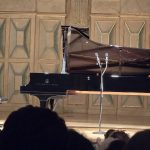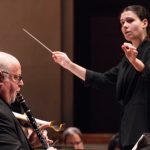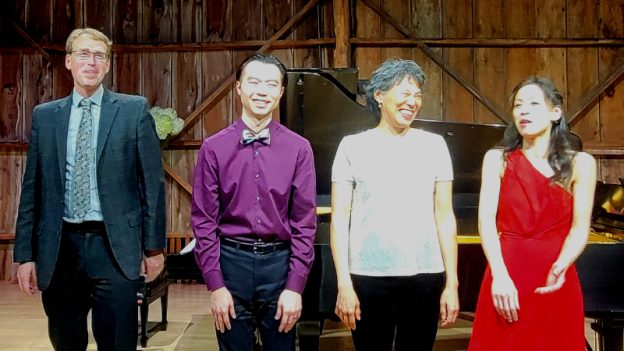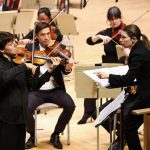August 17, 2025
Garth Newel Music Center
Warm Springs, VA – USA
“Piano Weekend II: Rapsodic”
Genevieve Lee, Jeannette Fang, Brian Hsu, and Jeremy Thompson, pianos.
Maurice RAVEL, Rapsodie espagnole M.54 for piano four hands or two pianos ad lib
Franz LISZT, arr. Ferrucio Busoni, Rhapsodie espagnole S.254 for piano and orchestra (two-piano rehearsal score)
Florent SCHMITT, Trois Rapsodies Op. 53 for two pianos
Franz LISZT, arr. Richard Kleinmichel, Hungarian Rhapsody No. 2 for two pianos, eight hands
Christopher Hill | 21 AUG 2025
Bath County, in the Appalachian region of the Old Dominion State, has for well over a century been welcoming summer visitors from the Virginia Piedmont as well as from more distant climes such as New York and Connecticut. Warm Springs, sometimes confused with Hot Springs, just down the road, lies in the western part of the county. It was there, in 1922, that 54-year-old painter William Sergeant Kendall bought 114 acres and began a new life with a new wife, the former Christine Herter, by building a new house (in Welsh: Garth Newel). Fast forward (past Kendall’s hobby of raising Arabian horses in the mountains and past his 1938 death in an Arabian horse accident) to 1973, when Christine Kendall, now in her early 80s, joined with members of the Rowe Quartet to found the Garth Newel Music Center for the study and performance of chamber music.
Today, in the mid-2020s, Garth Newel Music Center is an established summer destination for reliably high-quality chamber music-making in an environment that continues to soothe urban souls. The house itself, now listed in the National Register of Historic Places, has become a well-kept and inviting bed and breakfast with oodles of comfortable seating for private or group conversation. The Center also has a cluster of other buildings, including an intimate theater with seating for an audience of 150 or thereabouts. In the theater’s Green Room hang autographed photos of world-renowned classical artists from previous generations. And just off its Green Room lies a media center equivalent (if not superior) to one that might be found in a major metropolis.
For those who wish, concerts are followed by prix fixe meals, prepared by staff in the restaurant-style kitchen of an adjacent building. Food is served buffet style, with many tasty choices, including vegetarian and gluten-free options. The array of dessert items is likewise varied and impressive. Alcoholic beverages can be purchased; non-alcoholic beverages come with the meal.
June and July are chamber music months at Garth Newel, meaning that there are nine weekends with about eighteen concerts. Your reviewer was at Garth Newel to attend their annual all-keyboard weekend, this year featuring pianists Genevieve Fei-Wen Lee, Jeannette Fang, Brian Hsu, and Jeremy Thompson. The four had appeared the previous afternoon, a Saturday, in a demanding program that included Stravinsky’s Petrouchka (the complete ballet). Now they would turn to another demanding program, this time featuring Liszt and French impressionist composers.
The hall was packed. The concert opened with one of the French pieces, Ravel’s Rapsodie espagnole, written mostly in 1907–08, the same period that Ralph Vaughan Williams was studying with Ravel. “Written mostly” because the third of its four movements, “Habañera,” dates back to 1895; in 1897, Ravel paired “Habañera” with “Entre cloches” to form Sites auriculaires (a Satie-like title) for two pianos. Ten years later, in the summer and early autumn of 1907, Ravel tweaked “Habañera” a bit and nested it within three companion movements, playable either by piano four hands or two pianos. He completed the keyboard work Rapsodie espagnole that October.
At Garth Newel, the score was performed on two pianos by Genevieve Lee and Brian Hsu. Lee teaches at Pomona College in southern California; Hsu teaches at the University of Oregon. The two pianists began rehearsing together only after they arrived in Warm Springs, a few days prior to the concert. But you’d never guess, given the rapport they displayed and the precision they demonstrated when playing. Ravel’s Rapsodie has been performed, in its 1908 orchestration, many hundreds of times, so the music has a well-established performance tradition. Lee’s and Hsu’s interpretation was a sensitive rendition of this performance tradition. On Garth Newel Music Center’s YouTube channel, you can see and hear it for yourself:
Next on the program was a second Rhapsodie espagnole, this time from Franz Liszt by way of Ferruccio Busoni. Liszt toured Spain and Portugal in 1844 and 1845; in the latter year, Glinka wrote his orchestral Capriccio brillant sur la thème de la Jota arogonese and Liszt his Große Konzertfantasie über spanische Weisen for piano, both featuring the same Jota arogonese. Some thirteen years later, Liszt was sent a copy of the Glinka score, and he not only performed it with his Weimar orchestra, but he started thinking anew about writing music using Spanish and Portuguese themes. Accordingly, between 1858 and 1864 (the date on the fair copy), he crafted what, in my humble opinion, is one of his most mature and finished works.
The first half is based on “La Folia,” a solemn, ancient tune of Portuguese origin; Corelli, Scarlatti, Vivaldi, and Bach had all used it, and the tune (or, better, chord progression) is also the basis of Rachmaninoff’s much-played Variations on a Theme of Corelli. The second half of the Rhapsodie comprises all new variations on the Jota aragonese, written more in the manner of Glinka’s Capriccio brillant than of Liszt’s own, earlier Große Konzertfantasie. The Rapsodie espagnole became an instant hit after Hans von Bülow gave it a brilliant premiere. Today, over 150 years later, so many aspiring pianists have gambled on, and so many mature pianists have reveled in the solo version of the Rhapsodie that there are at least two well-established performing traditions for the work.
Where does Busoni come in? Well, Ferruccio Busoni is rightly well known for his effective transcriptions. Although not a member of Liszt’s circle in the 1870s or ’80s, Busoni in the early 1890s became deeply interested in Liszt, making over twenty transcriptions of his works and eventually contributing several volumes to a scholarly edition produced by the Franz Liszt Foundation. By 1894, Busoni had transformed the Rhapsodie espagnole into a work for piano and orchestra, at the same time — as is normal with such works — producing a rehearsal score in which a second piano plays an orchestral reduction. It is Busoni’s rehearsal score that was performed on Sunday by pianists Jeannette Fang and Jeremy Thompson, with Fang taking the solo part and Thompson the orchestral reduction.
As resident pianist with the Garth Newel Piano Quartet, Jeannette Fang performs an enormous amount of music over the course of a summer season. Just for starters, on Sunday of the first weekend, she gave an entire piano recital. Since then, she has played at least seven major nineteenth- and twentieth-century works as part of the Piano Quartet. And, as mentioned, the day before the concert your reviewer attended, she partook in several demanding works. To do this requires one to be both a quick study and a deft hand. As well as courageous. All those things Fang clearly is, as evidenced by her abundant energy and devil-may-care immersion in the Liszt-Busoni solo part.
Her performance (mainly in the first half) wasn’t note-perfect (and when it wasn’t, you knew Fang was displeased because at just those moments she tended to stick out her tongue), but it was solidly secure in the high end of Lisztian commitment. Ninety-eight percent of her playing perfectly conveyed both Liszt’s pianistic confidence and his musical passion. How, I wondered, could such a slender body produce the massive Russian-piano-school sonorities we in the audience were hearing? The answer to this question was suggested after the concert: Fang prefers a life of athleticism, one shared by her husband, an actor, who appears almost as energetic.
Those who have played orchestral reductions for piano know how unpianistic and awkward they can be. One would never guess this, however, from the way Jeremy Thompson handled his ungrateful task. His performance was a model of responsive and disciplined musicality.
Florent Schmitt’s Opus 53, Trois rapsodies, was without question the most technically and musically challenging work on the program. It was performed, like the Ravel, by Genevieve Lee and Brian Hsu. Given its complexities, you will not be surprised to hear that your reviewer thinks the pianists needed more time to get to know the work. The number one reason they needed more time is that Schmitt’s Opus 53, unlike the Ravel and Liszt works on the program, has no widely established performance tradition (as of 2025).
Technically, the pianist duo was just as superb in its ensemble as it had been earlier in the Ravel. Further, Lee and Hsu are much too good musicians to have just played the notes; they also played the phrases very sensitively. But it seemed to this reviewer that Schmitt’s leading voices were often buried in detail, and thus that the duo didn’t know where the music was really going. As a contextual example: it was Ravel who joined Schmitt in an early performance of Opus 53. And it was not many months after doing so that Ravel sketched a piece of his own that he titled “Vienne,” a piece rather reminiscent of Schmitt’s progression in opus 53 from innocent waltz to violence.
Sixteen years later, Ravel’s sketch became La valse, some of the best music he ever wrote. Ravel’s later score is alive with his personal insights, sharpened by front-line experience in the Great War. Nonetheless, it echoes more than a little of what Schmitt did sixteen years earlier in his Opus 53. No doubt because Schmitt is not as well known as Ravel today, the pianists tried to sell his music to the audience as charming froth, and they played it accordingly. Thanks to their technical panache, their performance was warmly received. Perhaps few if any in the audience (besides Schmitt expert Phillip Nones) knew what they were missing. That said, one can only applaud this duo for what was, in the event, a superior performance of a great work that lacks a performance tradition. They are helping start one, helping shape the future of classical music. Hats off to Genevieve Lee and Brian Hsu!
The final piece on the program was Richard Kleinmichel’s arrangement of the Liszt Hungarian Rhapsody No. 2 for two pianos, eight hands, first published in 1886. For this famous piece, the two ladies performed together stage right, and the two gentlemen performed together stage left. All four performers were more than up to their task and provided the audience with great pleasure. Nevertheless, if this were a competition (and your reviewer has witnessed some), it would be the ladies who came out the winners. The gentlemen performed well and without errors; the ladies played with sizzling style. The blend of the two was, actually, excellent, and certainly the audience was too busy enjoying the performance to keep score. For all its obviousness, then, the finale proved a great success. The four performers took only two curtain calls, but the house continued applauding for some time after the second. ‘Twas a fine afternoon’s music making. ■
EXTERNAL LINKS:
- Garth Newel Music Center: garthnewel.org

Read more by Christopher Hill.
RECENT POSTS
 Jan Lisiecki transforms a marathon of preludes into a compelling narrative at Spivey Hall • 26 Nov 2025
Jan Lisiecki transforms a marathon of preludes into a compelling narrative at Spivey Hall • 26 Nov 2025 Dallas Symphony’s assistant conductor rises to the challenge in a program of premieres and familiar works • 25 Nov 2025
Dallas Symphony’s assistant conductor rises to the challenge in a program of premieres and familiar works • 25 Nov 2025




.png)